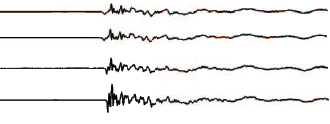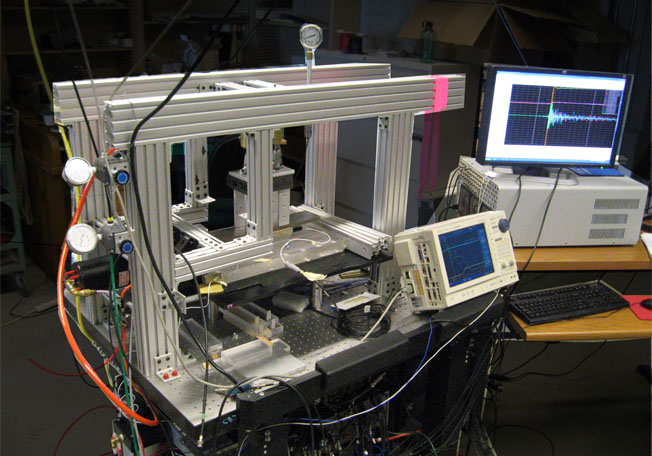Repeating earthquake sequences and laboratory stick-slip
 Repeating earthquake sequences are sets of earthquakes with very similar looking seismograms (as shown on right) that are thought to be caused by the repeated rupture of the a specific section of a fault. By studying the subtle variations between repeating earthquakes, seismologists can infer some of the properties of the faults that produced them.
Repeating earthquake sequences are sets of earthquakes with very similar looking seismograms (as shown on right) that are thought to be caused by the repeated rupture of the a specific section of a fault. By studying the subtle variations between repeating earthquakes, seismologists can infer some of the properties of the faults that produced them.
We can complement field observations by studying certain aspects of faulting and earthquake production in small-scale laboratory models. A laboratory apparatus that I built in the Glaser Lab at UC Berkeley is shown in the figure below. In laboratory experiments, it is possible to measure changes in stress and fault slip--quantities that are extremely difficult to measure in the earth. The apparatus shown below is unique in that it was specifically designed with the analysis of seismic waves in mind. In a study which addressed the effects of loading rate and the time that a fault is allowed to heal between successive earthquakes, my colleagues and I compared laboratory results to observations of repeating earthquake sequences recorded with the HRSN seismic network near Parkfield, CA.

The figure below shows the times of repeating M 1.2 earthquakes in a sequence before and after the 2004 M6 Parkfield earthquake (indicated by a vertical gray line in the left panel). Before the 2004 earthquake, the small earthquakes repeated about once every year. Immediately after the earthquake, the recurrence time (tr) of the repeater decreased to less than one day, presumably due to an increase in the loading rate due to afterslip. Over the next few years, as the afterslip from the 2004 Parkfield event gradually subsided, the recurrence time of the repeating earthquake increased, and nearly returned to its pre-2004 recurrence interval of about 1 year.

When analogous loading conditions were applied to small laboratory samples composed of acrylic plastic, the sequence of stick-slip events behaved similarly to the way in which the repeating earthquake sequence behaved. When the sample was loaded rapidly, to represent loading from afterslip, the stick-slip events occurred every 100 ms or so. As the loading rate was decreased, the recurrence time between successive events increased systematically up to 10 seconds or more. This data provided us with over two orders of magnitude spread in the recurrence interval, which allowed us to observe very subtle trends above the scatter in the data, such as an increase in the strength of the simulated fault with increasing recurrence time.
In the laboratory, systematic changes in the frequency content of radiated seismic waves were also observed to vary with the changing recurrence time. When investigated, it was found that similar but more subtle spectral changes were indeed present in the ground motions recorded with the HRSN network (as shown in the left panel of the figure above). It is assumed that when the recurrence time between repeating earthquakes and repeating stick-slip events increases, the seism genic fault patch heals for a longer time. Therefore the increase in high frequencies observed at longer recurrence times is attributed to the effects of increased fault healing.
More information can be found in the following publication:
McLaskey, G. C., Thomas, A. M., Glaser, S. D., and Nadeau, R. M. (2012) Fault healing promotes high frequency earthquakes in laboratory experiments and on natural faults Nature 491, pp. 101-104.